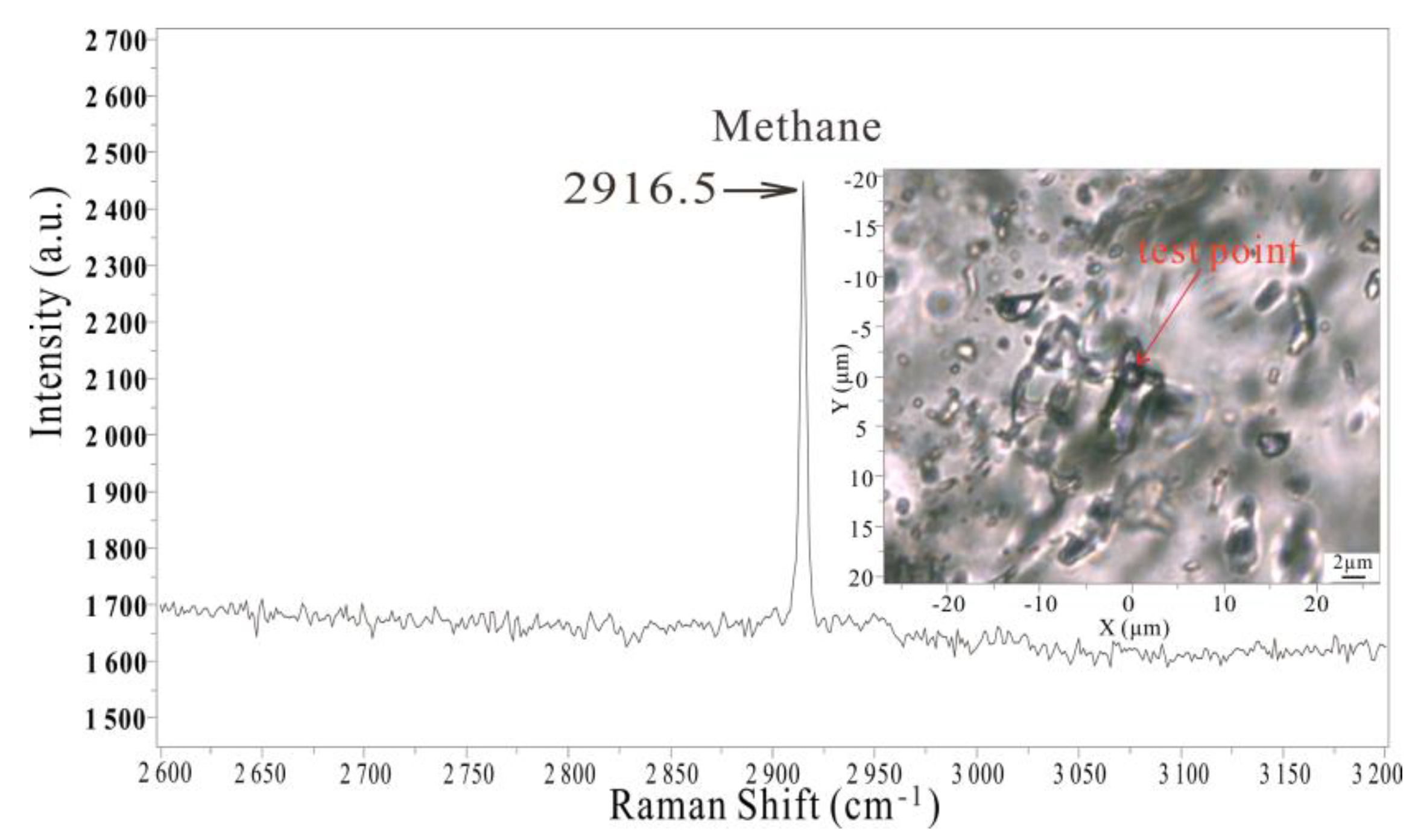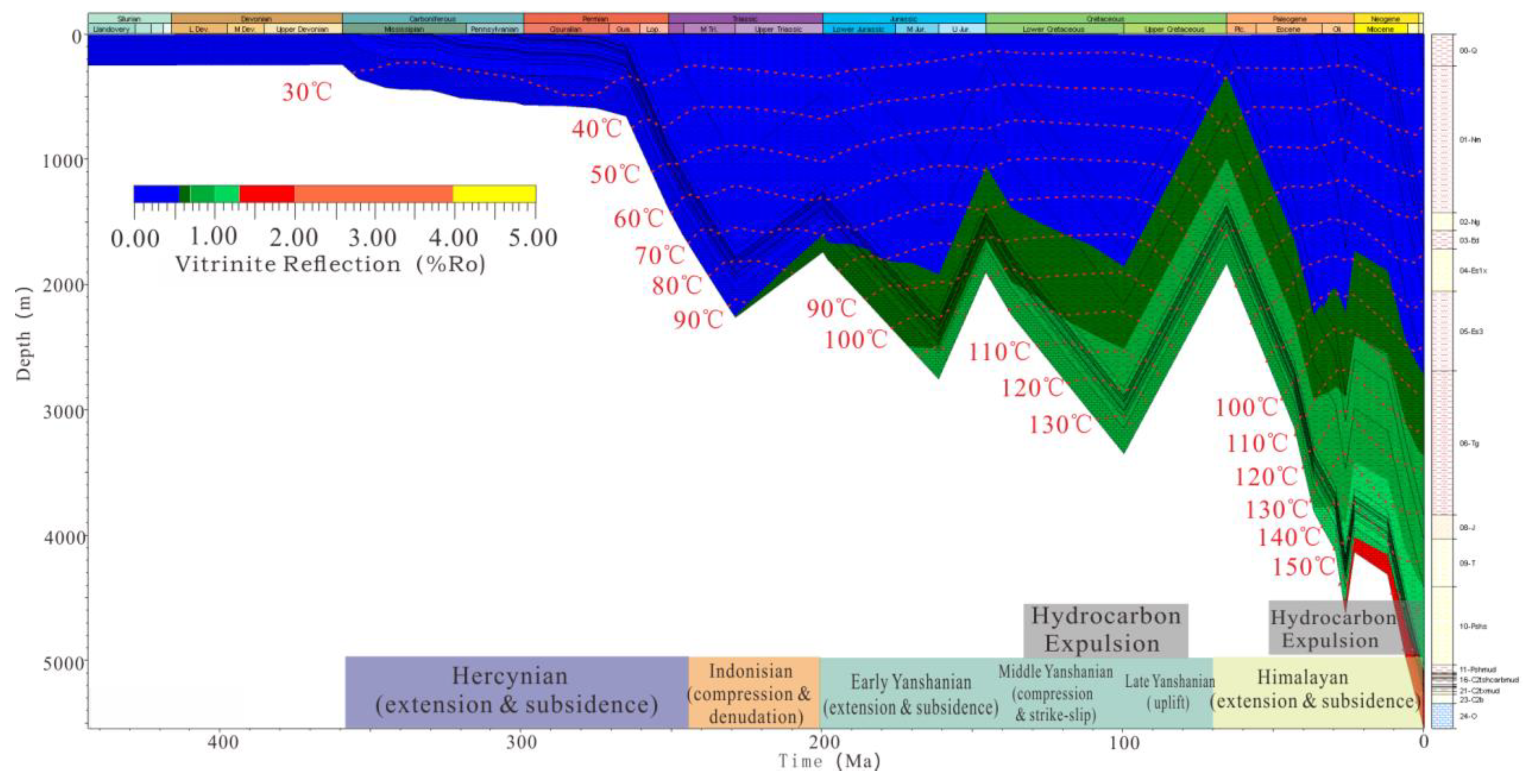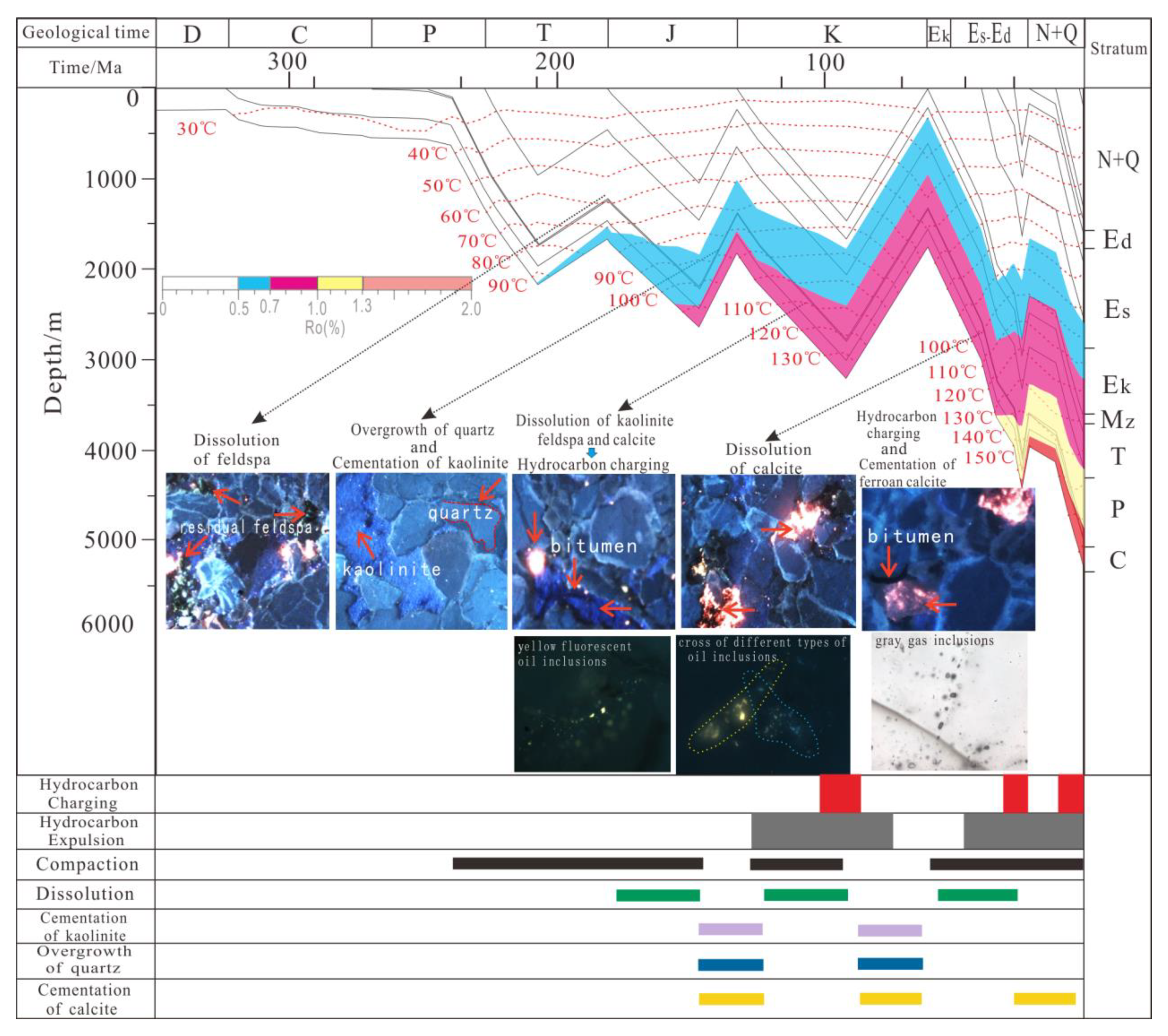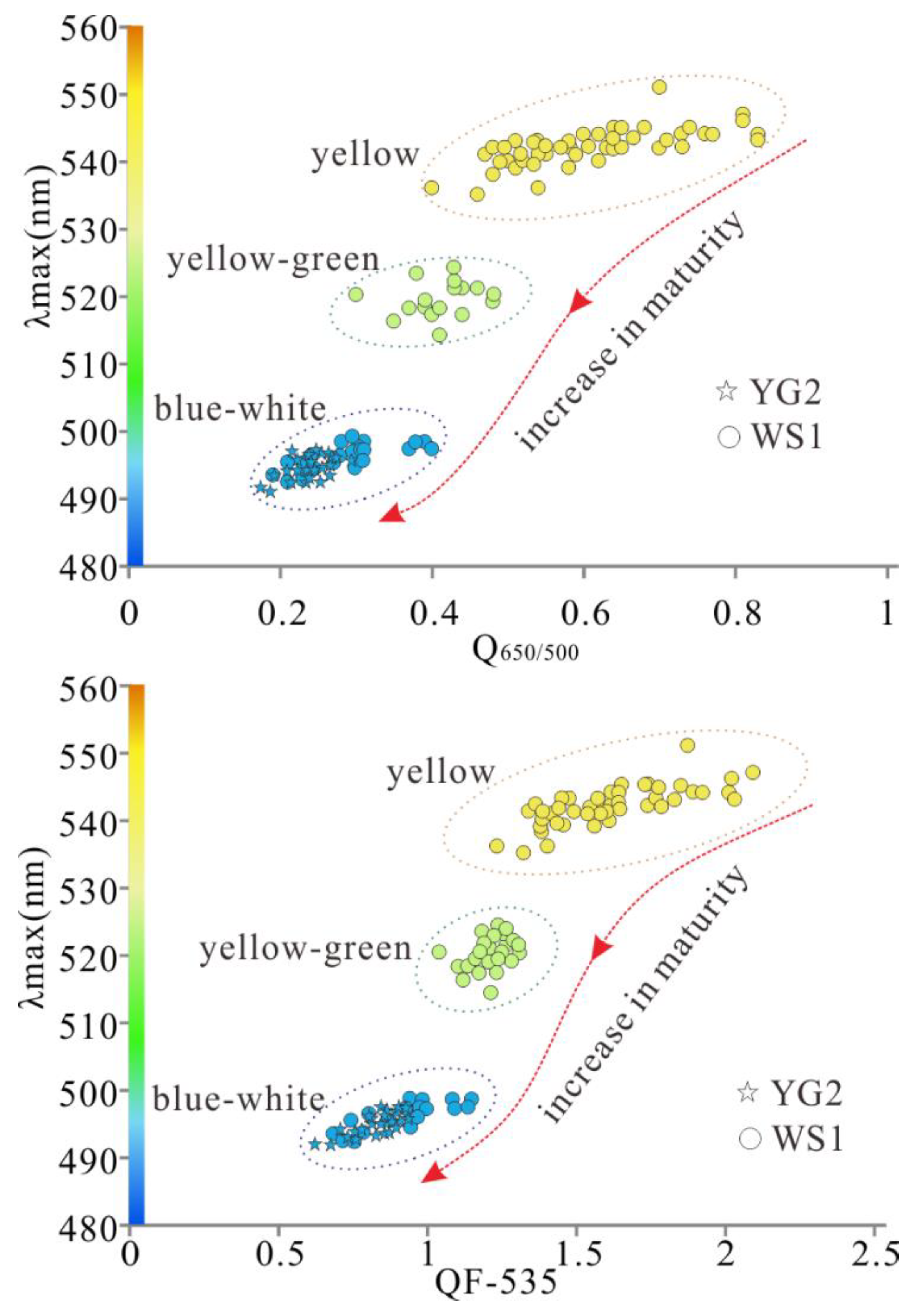Hydrocarbon Charging and Accumulation in the Permian Reservoirs of the Wumaying Buried Hill, Huanghua Depression, Bohai Bay Basin, China
Abstract
:1. Introduction
2. Geological Backgrounds
2.1. Stratigraphy
2.2. Structure and Evolution
3. Samples and Methods
4. Results
4.1. Petrography and Fluorescence Observation
4.2. Diagenesis of Minerals and Residual Bitumen
4.3. Microthermometry
4.4. Laser Raman Spectroscopy Features
4.5. Burial and Thermal History
5. Discussion
5.1. Origin Analysis of Oil and Gas
5.2. Diagenetic Process and Hydrocarbon Charging Events
5.3. Analysis of Hydrocarbon Charging Period
5.4. Hydrocarbon Charging and Accumulation History
5.5. Differences in Hydrocarbon Charging and Accumulation
6. Conclusions
- (1)
- Tectonic activities controlled hydrocarbon charging and diagenesis, and the coupling relationship between diagenesis and accumulation is as follows: compaction (persisted in the process of burial) → dissolution of feldspar → overgrowth of quartz and cementation of kaolinite → dissolution of minerals → hydrocarbon charging → cementation of calcite → dissolution of calcite and hydrocarbon charging → cementation of ferroan calcite.
- (2)
- The tectonic subsidence in early–middle Cretaceous caused hydrocarbons to be discharged from the coal-measure source rocks at a small scale. Under the channeling of faults and micro cracks, oil and gas accumulation was formed in the first period, and the accumulation time was 112–93 Ma. In the late Cretaceous, large-scale uplift exposed and damaged the reservoir, and part of the oil was converted into bitumen. In the middle-late Paleogene, the subsidence of strata caused the coal-measure to expel mature oil and gas, and the accumulation time of a large number of mature oil and gas was 34–24 Ma. The tectonic uplift at the end of Paleogene made the hydrocarbon generation process slow or stagnant, but did not cause the damage of reservoirs. Since the Neogene, plenty of gas and some high-mature oil have been expelled due to the large subsidence, and entered the reservoir under the channeling of active faults; the accumulation time was 11–0 Ma.
- (3)
- The reasons for the difference in Permian oil and gas charging in the YG2 and WS1 wells are as follows: the scale of the early period of hydrocarbon charging is small, and hydrocarbons are preferentially charged into the Permian reservoirs in the nearest YG2 well through the fault, while it is insufficient to support oil and gas charging into the WS1 well. The late period of charging is large in scale and lasted for a long time, during which the vicinity of the WS1 and YG2 wells became the high positions, and oil and gas could be charged into both wells.
- (4)
- The microfractures of Permian reservoirs in the Wumaying buried hill are the main storage spaces of oil and gas, and the fractured reservoirs should be explored in the future.
Author Contributions
Funding
Institutional Review Board Statement
Informed Consent Statement
Data Availability Statement
Acknowledgments
Conflicts of Interest
References
- Zhao, X.Z.; Pu, X.G.; Jiang, W.Y.; Zhou, L.H.; Jin, F.M.; Xiao, D.Q.; Fu, L.X.; Li, H.J. An exploration breakthrough in Paleozoic petroleum system of Huanghua Depression in Dagang Oilfield and its significance, North China. Pet. Explor. Dev. 2019, 46, 651–663. [Google Scholar] [CrossRef]
- Lyu, X.Y.; Jiang, Y.L.; Jiang, W.Y.; Li, H.J.; Liu, J.D. Genetic types and source of Meso-Paleozoic crude oil in the Huanghua Sub-basin. J. China Univ. Min. Technol. 2019, 48, 1290–1300. (In Chinese) [Google Scholar]
- Jin, F.M.; Wang, X.; Li, H.J.; Wu, X.S.; Fu, L.X.; Lou, D.; Zhang, J.N.; Feng, J.Y. Formation of the primary petroleum reservoir in Wumaying inner buried-hill of Huanghua Depression, Bohai Bay Basin, China. Pet. Explor. Dev. 2019, 46, 543–552. [Google Scholar] [CrossRef]
- Wu, Z.P.; Zhang, F.P.; Li, W.; You, P.F.; Fu, L.X.; Li, H.J.; Lou, D. Apatite fission track evidence of Mesozoic tectonic evolution in the Huanghua depression. J. China Univ. Min. Technol. 2020, 49, 131–144. (In Chinese) [Google Scholar]
- Parnell, J.; Green, P.F.; Watt, G.; Middleton, D. Thermal history and oil charge on the UK Atlantic margin. Pet. Geosci. 2005, 11, 99–112. [Google Scholar] [CrossRef]
- Bourdet, J.; Pironon, J.; Levresse, G.; Tritlla, J. Petroleum accumulation and leakage in a deeply buried carbonate reservoir, Nispero field (Mexico). Mar. Pet. Geol. 2010, 27, 126–142. [Google Scholar] [CrossRef]
- Wilkinson, M.; Haszeldine, R.S.; Fallick, A.E. Hydrocarbon filling and leakage history of a deep geopressured sandstone, Fulmar Formation, United Kingdom North Sea. Am. Assoc. Petrol. Geol. Bull. 2006, 90, 1945–1961. [Google Scholar] [CrossRef]
- Pironon, J.; Bourdet, J. Petroleum and aqueous inclusions from deeply buried reservoirs: Experimental simulations and consequences for overpressure estimates. Geochim. Cosmochim. Acta 2008, 72, 4916–4928. [Google Scholar] [CrossRef]
- Liu, K.Y.; Bourdet, J.; Zhang, B.S.; Zhang, N.; Lu, X.S.; Liu, S.B.; Pang, H.; Li, S.; Guo, X.W. Hydrocarbon charge history of the Tazhong Ordovician reservoirs, Tarim Basin as revealed from an integrated fluid inclusion study. Pet. Explor. Dev. 2013, 40, 183–193. [Google Scholar] [CrossRef]
- Parnell, J. Potential of palaeofluid analysis for understanding oil charge history. Geofluids 2010, 10, 73–82. [Google Scholar]
- Stasiuk, L.D.; Snowdon, L.R. Fluorescence micro-spectrometry of synthetic and natural hydrocarbon fluid inclusions: Crude oil chemistry, density and application to petroleum migration. Appl. Geochem. 1997, 12, 229–241. [Google Scholar] [CrossRef]
- Munz, I.A.; Wangen, M.; Girard, J.; Lacharpagne, J.; Johansen, H. Pressure-temperature-time-composition (P-T-t-X) constraints of multiple petroleum charges in the Hild field, Norwegian North Sea. Mar. Pet. Geol. 2004, 21, 1043–1060. [Google Scholar] [CrossRef]
- Dutkiewicz, A.; Rasmussen, B.; Buick, R. Oil preserved in fluid inclusions in archaean sandstones. Nature 1998, 395, 885–888. [Google Scholar] [CrossRef]
- Ferket, H.; Guilhaumou, N.; Roure, F.; Swennen, R. Insights from fluid inclusions, thermal and pvt modeling for paleo-burial and thermal reconstruction of the córdoba petroleum system (Ne Mexico). Mar. Pet. Geol. 2011, 28, 936–958. [Google Scholar] [CrossRef]
- Zhao, X.Z.; Zhang, L.P.; Jin, F.M.; Wang, Q.; Bai, G.P.; Li, Z.Y.; Wang, J. Hydrocarbon charging and accumulation history in the niudong buried hill field in the baxian depression, eastern china. Mar. Pet. Geol. 2017, 88, 343–358. [Google Scholar] [CrossRef]
- Yang, R.Z.; Zhao, X.Z.; Li, H.J.; Zhao, C.Y.; Pu, X.G.; Liu, H.T.; Fu, L.X.; Li, C.M. Hydrocarbon expulsion characteristics and hydrocarbon supply model of the upper Paleozoic source kitchen in Huanghua depression. J. China Univ. Min. Technol. 2020, 49, 384–397. (In Chinese) [Google Scholar]
- Han, G.M.; Wu, X.S.; Cui, Y.; Fu, L.X.; Li, H.J.; Wang, H.; Duan, R.M.; Guo, S.W.; Lou, D.; Diao, L.Y. Characteristics, control factors and development models of Permian compact sandstone reservoirs in Huanghua depression, Bohai Bay Basin. China Pet. Explor. 2019, 24, 509–519. (In Chinese) [Google Scholar]
- Zhang, F.P.; Wu, Z.P.; Li, W.; Zhu, J.C.; Fu, L.X.; Li, H.J.; Lou, D.; Zhao, Y.G. Structural characteristics and its tectonic evolution of Huanghua depression during the Indosinian-Yanshanian, 2019. J. China Univ. Min. Technol. 2019, 48, 842–857. (In Chinese) [Google Scholar]
- Zhang, Z.P.; Luo, B. Structural characteristics of Wumaying area in southern Huanghua Depression, the Bohai Bay Basin and their petroleum geology significance. Nat. Gas Explor. Dev. 2017, 40, 31–37. (In Chinese) [Google Scholar]
- Fu, L.X.; Zhou, B.X. Limited tectonic conditions for natural gas accumulation in Paleozoic group in southern Huanghua Depression. Nat. Gas Geosci. 2003, 14, 254–259. (In Chinese) [Google Scholar]
- Lai, J.; Wang, G.W.; Wang, S.; Cao, J.T.; Li, M.; Pang, X.J.; Zhou, Z.L.; Fan, X.Q.; Dai, Q.Q.; Yang, L.; et al. Review of diagenetic facies in tight sandstones: Diagenesis, diagenetic minerals, and prediction via well logs. Earth-Sci. Rev. 2018, 185, 234–258. [Google Scholar] [CrossRef]
- Qiu, N.S.; Zuo, Y.H.; Chang, J.; Xu, W.; Zhu, C.Q. Comparison of Meso Cenozoic thermal systems of typical basins in eastern and Western China. Front. Earth. Sci. PRC 2015, 22, 157–168. [Google Scholar]
- Dai, J.X. Identifitification and distinction of various alkane gases. Sci. China Ser. B 1992, 35, 1246–1257. [Google Scholar]
- Peters, K.E.; Moldowan, J.M.; Sundararaman, P. Effects of hydrous pyrolysis on biomarker thermal maturity parameters: Monterey Phosphatic and Siliceous members. Org. Geochem. 1990, 15, 249–265. [Google Scholar] [CrossRef]
- Moldowan, J.M.; Serfeit, W.K.; Gallegos, E.J. Relationship between petroleum composition and depositional environment of petroleum source rocks. AAPG Bull. 1985, 69, 1255–1268. [Google Scholar]
- Brassell, S.C.; Eglinton, G.; Fu, J.M. Biological marker compounds as indicators of the depositions history of the Maoming oil shale. Org. Geochem. 1986, 10, 927–941. [Google Scholar] [CrossRef]
- Goldstein, R.H. Fluid inclusions in sedimentary and diagenetic systems. Lithos 2001, 55, 159–193. [Google Scholar] [CrossRef]
- Hosa, A.; Wood, R.A.; Corbett, P.W.M.; Schiffer de Souza, R.; Roemers, E. Modelling the impact of depositional and diagenetic processes on reservoir properties of the crystal-shrub limestones in the ‘Pre-Salt’ Barra Velha Formation, Santos Basin, Brazil. Mar. Pet. Geol. 2020, 112, 104100. [Google Scholar] [CrossRef]
- Zhu, R.K.; Zou, C.N.; Zhang, N.; Wang, X.S.; Cheng, R.; Liu, L.H.; Zhou, C.M.; Song, L.H. Diagenetic fluidsevolution and genetic mechanism of tight sandstonegas reser-voirs: A case study of upper Triassic Xujiahe Formation in Si-chuan basin. Sci. China Ser. D Earth Sci. 2009, 39, 327–339. (In Chinese) [Google Scholar]
- Lazo, D.E.; Dyer, L.G.; Alorro, R.D. Silicate, phosphate and carbonate mineral dissolution behaviour in the presence of organic acids: A review. Miner. Eng. 2017, 100, 115–123. [Google Scholar] [CrossRef]
- Wang, J.; Cao, Y.C.; Liu, K.Y.; Liu, J.; Xue, X.J.; Xu, Q.S. Pore fluid evolution, distribution and water-rock interactions of carbonate cements in red-bed sandstone reservoirs in the dongying depression, China. Mar. Pet. Geol. 2016, 72, 279–294. [Google Scholar] [CrossRef]
- Munz, I.A. Petroleum inclusions in sedimentary basins: Systematics, analytical methods and applications. Lithos 2001, 55, 195–212. [Google Scholar] [CrossRef]
- Volk, H.; Fuentes, D.; Fuerbach, A.; Miese, C.; Koehler, W.; Bärsch, N.; Barcikowski, S. First on-line analysis of petroleum from single inclusion using ultrafast laser ablation. Org. Geochem. 2010, 41, 74–77. [Google Scholar] [CrossRef]
- Volk, H.; George, S.C. Using petroleum inclusions to trace petroleum systems—A review. Org. Geochem. 2019, 129, 99–123. [Google Scholar] [CrossRef]
- Xu, S.; Hao, F.; Xu, C.G.; Zou, H.Y.; Zhang, X.T.; Zong, Y.; Zhang, Y.Y.; Cong, F.Y. Hydrocarbon migration and accumulation in the northwestern bozhong subbasin, bohai bay basin, China. J. Pet. Sci. Eng. 2018, 172, 477–488. [Google Scholar] [CrossRef]
- Pang, X.Q.; Li, M.W.; Li, S.M.; Jin, Z.J. Geochemistry of petroleum systems in the niuzhuang south slope of Bohai Bay basin: Part 3. Estimating hydrocarbon expulsion from the Shahejie formation. Org. Geochem. 2005, 36, 497–510. [Google Scholar] [CrossRef]
- Rio, D.; Philp, R.P.; Allen, J. Nature and geochemistry of high molecular weight hydrocarbons (above C40) in oils and solid bitumens. Org. Geochem. 1992, 18, 541–553. [Google Scholar]
- Fu, L.X.; Lou, D.; Li, H.J.; Qi, J.F.; Feng, J.Y.; Guo, J.Y.; Wu, X.S.; Zhao, Y.G. Control effect of Indosinian-Yanshan movement on the formation of buried hill in Dagang exploration area. Acta Pet. Sin. 2016, 37, 19–30. (In Chinese) [Google Scholar]
- Fu, X.F.; Lyu, Y.F.; Fu, G.; Wen, H.J. Quantitative simulation experiment and evaluation method for ver-tical seal of overthrust. Chin. J. Geol. 2004, 39, 223–233. (In Chinese) [Google Scholar]














| Well | Sam. No. | Depth/m | In. Location | λmax/nm | Q650/500 | QF535 | Gas/Liquid Ratio | GOI/% |
|---|---|---|---|---|---|---|---|---|
| WS1 | WS1-1-1 | 4857.7 | calcite cement | 492 | 0.19 | 0.67 | 19.24 | 5.8 |
| WS1 | WS1-1-3 | 4857.7 | microfractures within quartz | 493 | 0.22 | 0.74 | ||
| WS1 | WS1-2-1 | 4858.23 | microfractures through quartz | 494 | 0.24 | 0.8 | 5.51 | 8.1 |
| WS1 | WS1-2-3 | 4858.23 | calcite cement | 494 | 0.24 | 0.82 | ||
| WS1 | WS1-3-1 | 4858.8 | microfractures through quartz | 494 | 0.2 | 0.71 | 9.4 | 10.5 |
| WS1 | WS1-3-2 | 4858.8 | microfractures within quartz | 496 | 0.27 | 0.91 | ||
| WS1 | WS1-4-2 | 4858.82 | microfractures through quartz | 497 | 0.25 | 0.86 | 5.68 | 11.1 |
| WS1 | WS1-5-1 | 4859.33 | microfractures within quartz | 497 | 0.25 | 0.85 | 8.69 | 7.2 |
| WS1 | WS1-5-2 | 4859.33 | microfractures through quartz | 497 | 0.27 | 0.92 | ||
| WS1 | WS1-6-1 | 4859.35 | calcite cement | 495 | 0.24 | 0.8 | n.d. | 6.5 |
| WS1 | WS1-7-1 | 4859.48 | calcite cement | 496 | 0.23 | 0.81 | 8.83 | 11.8 |
| WS1 | WS1-10-1 | 4859.84 | microfractures within quartz | 495 | 0.26 | 0.84 | 7.7 | 2 |
| WS1 | WS1-10-2 | 4859.84 | microfractures through quartz | 493 | 0.22 | 0.75 | ||
| YG2 | YG2-2-1 | 4699.04 | microfractures within quartz | 542 | 0.48 | 1.36 | 6.1 | 0.5 |
| YG2 | YG2-2-3 | 4699.04 | microfractures within quartz | 495 | 0.27 | 0.87 | ||
| YG2 | YG2-3-1 | 4700.15 | microfractures within quartz | 545 | 0.64 | 1.65 | 5.5 | 2 |
| YG2 | YG2-3-2 | 4700.15 | microfractures within quartz | 492 | 0.23 | 0.76 | ||
| YG2 | YG2-5-2 | 4701.63 | microfractures within quartz | 543 | 0.71 | 1.83 | 2.64 | 4.8 |
| YG2 | YG2-6-1 | 4702 | microfractures through quartz | 539 | 0.51 | 1.46 | 1.52 | 6 |
| YG2 | YG2-6-4 | 4702 | microfractures within quartz | 517 | 0.4 | 1.17 | ||
| YG2 | YG2-7-2 | 4702.6 | microfractures within quartz | 493 | 0.19 | 0.68 | 9.28 | 4 |
| YG2 | YG2-7-3 | 4702.6 | microfractures within quartz | 544 | 0.62 | 1.64 | ||
| YG2 | YG2-8-1 | 4702.62 | microfractures within quartz | 541 | 0.59 | 1.61 | 1.46 | 7.2 |
| YG2 | YG2-9-1 | 4702.8 | microfractures within quartz | 543 | 0.51 | 1.45 | 2.06 | 7.9 |
| YG2 | YG2-10-1 | 4703.79 | microfractures within quartz | 542 | 0.57 | 1.55 | 2.1 | 2.05 |
| YG2 | YG2-10-2 | 4703.79 | calcite cement | 551 | 0.7 | 1.87 | ||
| YG2 | YG2-11-1 | 4704.17 | calcite cement | 536 | 0.54 | 1.4 | 2.47 | 7.5 |
| YG2 | YG2-12-3 | 4705.24 | microfractures within quartz | 522 | 0.43 | 1.27 | 2.39 | 4.9 |
| YG2 | YG2-12-4 | 4705.24 | microfractures within quartz | 498 | 0.31 | 0.98 | ||
| YG2 | YG2-13-1 | 4705.26 | calcite cement | 542 | 0.65 | 1.61 | 4.3 | 6.39 |
| YG2 | YG2-13-3 | 4705.26 | microfractures within quartz | 542 | 0.7 | 1.78 | ||
| YG2 | YG2-14-1.1 | 4705.65 | microfractures within quartz | 547 | 0.81 | 2.09 | 5.58 | 2.89 |
| YG2 | YG2-14-1.2 | 4705.65 | microfractures within quartz | 497 | 0.3 | 0.97 | ||
| YG2 | YG2-15-3.1 | 4706.2 | microfractures within quartz | 540 | 0.52 | 1.39 | 7.03 | 2.05 |
| YG2 | YG2-16-1 | 4706.4 | microfractures within quartz | 543 | 0.71 | 1.77 | 5.68 | 6.16 |
| YG2 | YG2-16-2.1 | 4706.4 | microfractures through quartz | 496 | 0.24 | 0.8 | ||
| YG2 | YG2-16-4.3 | 4706.4 | calcite cement | 544 | 0.76 | 1.89 | ||
| YG2 | YG2-17-1 | 4706.7 | calcite cement | 521 | 0.43 | 1.21 | 4.92 | 1.06 |
| YG2 | YG2-17-2 | 4706.7 | microfractures within quartz | 519 | 0.39 | 1.16 | ||
| YG2 | YG2-18-1 | 4706.75 | microfractures within quartz | 496 | 0.29 | 0.95 | 2.15 | 1.1 |
| YG2 | YG2-18-3 | 4706.75 | microfractures within quartz | 543 | 0.54 | 1.47 | ||
| YG2 | YG2-20-1 | 4707.82 | microfractures within quartz | 496 | 0.29 | 0.95 | n.d. | 4.8 |
| YG2 | YG2-26-2 | 4705.9 | calcite cement | 519 | 0.48 | 1.28 | 7.72 | 1.1 |
| Characteristic Parameters | Oil from Permian Reservoirs | Oil from Source Rocks of Paleogene |
|---|---|---|
| Ts/Tm | 1.08 | 1.5 |
| C30 hopanoid/C29 hopanoid | 1.64 | 3.06 |
| C27 regular sterane/C29 regular sterane | 1.39 | 0.39 |
| C19 tricyclic terpane/C23 tricyclic terpane | 0.78 | 0.16 |
| Tricyclic terpane/C30 hopanoid | 1.13 | 0.11 |
Publisher’s Note: MDPI stays neutral with regard to jurisdictional claims in published maps and institutional affiliations. |
© 2021 by the authors. Licensee MDPI, Basel, Switzerland. This article is an open access article distributed under the terms and conditions of the Creative Commons Attribution (CC BY) license (https://creativecommons.org/licenses/by/4.0/).
Share and Cite
Yang, R.; Zhao, X.; Zhao, C.; Pu, X.; Liu, H.; Li, H.; Fu, L.; Tang, Y. Hydrocarbon Charging and Accumulation in the Permian Reservoirs of the Wumaying Buried Hill, Huanghua Depression, Bohai Bay Basin, China. Energies 2021, 14, 8109. https://doi.org/10.3390/en14238109
Yang R, Zhao X, Zhao C, Pu X, Liu H, Li H, Fu L, Tang Y. Hydrocarbon Charging and Accumulation in the Permian Reservoirs of the Wumaying Buried Hill, Huanghua Depression, Bohai Bay Basin, China. Energies. 2021; 14(23):8109. https://doi.org/10.3390/en14238109
Chicago/Turabian StyleYang, Runze, Xianzheng Zhao, Changyi Zhao, Xiugang Pu, Haitao Liu, Hongjun Li, Lixin Fu, and Ying Tang. 2021. "Hydrocarbon Charging and Accumulation in the Permian Reservoirs of the Wumaying Buried Hill, Huanghua Depression, Bohai Bay Basin, China" Energies 14, no. 23: 8109. https://doi.org/10.3390/en14238109





